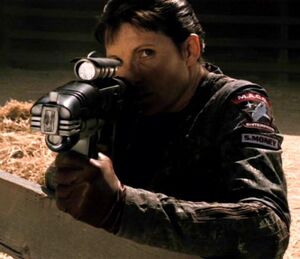Type III-C Phaser

A phaser rifle (often referred to as a Type III-C Phaser) is a rifle variation of the standard phaser used by the Federation. it is primarily used by Starfleet Marines
25th century phaser rifles have sixteen power settings, fully-autonomous recharge capability, multiple-target acquisition, and gyro-stabilization.
The weapon fires blue pulses of concentrated energy at its target and was capable of multiple settings. The observed power settings range from stun, to kill, to a high-power kill setting capable of blasting a perfectly symmetrical hole over an inch in diameter through a human torso.
Power levels could be changed by manipulating either manually or through the up-link to the Pallus Helmet. Rotating the power level selector forward / away from the user appears to increase the power level.
The weapon features a tubular stock, vertical fore-grip, and a multifunction scope that can be retracted into the body of the weapon. There may also be a sniper variant, though it is unclear whether or not the sniper / designated marksman version is a distinct weapon system or a Type III-C phase-rifle with a retractable barrel or separate barrel attachment.
History[edit]
With the threat of the Borg, the United Federation of Planets set out to create and even more powerful and resilient Phaser weapon that could be utilized by Heavy Troops. The Type III-C was developed to meet those needs.
The weapon underwent extensive battlefield testing and deployment during the Federation Civil War where it was utilized by both sides.
The Marine Rifle differs from the standard Mark-3b in several ways. The integral taccorder unit gives greater tactical advantage to a marine than a normal rifle with its targeting capabilities- the taccorder can be adjusted to various settings making it 'identify' various power, life or communications signals.
This makes it possible to detect/suppress enemies that are not yet visible. The design follows principles of the marine pistol. The III-C was specifically reinforced to allow a Marine to use it as weapon against an assailant wielding a Bat'leth or similar weaponry in close quarters, without damaging it. This is another factor in the III-C being heavier than similar Starfleet Rifles.
Statistical Information[edit]
- Length: 30 in or 76.2cm
- Weight: 9.9 lbs or 4.5 kg
- Total energy reserve: 12x10^8 megajoules in hotswappable sarium-krellide pack.
- Power settings: 1-16 operatable by press buttons on the control panel, or with Pallas Helmet.
Firing Modes[edit]
Changed with the control button on the control panel, or by optical/verbal commands through the Pallas Helmet.
- Single - as in any other phaser weapon, one shot per pull of trigger.
- Sustained - A sustained beam or stream, useful for cutting through obstacles down or wearing down force fields or the target's resistance. Activated by holding the trigger down after firing.
- Pulse - capable of firing up to 25 'pulses' of energy within a second. Burstfire coils store energy in a similar way to the phaser cannon charging all the coils with the energy for the imminent firing. Coils cannot hold the energy indefinitely and the energy is let to radiate' out of the coils to avoid overload. This reduces the life span of the energy pack by some 45%-65% and causes the coils to glow visible light and warmth and emit hums ranging from 30-60 decibels limiting its use mainly to battlefield conditions. There is a delay of a 0.02 seconds between pulses allowing the firer to 'walk the fire' between targets or 'hose' moving targets.
The difference between the rifle and pistol is the coiling system. Pistols contain five coils but rifles have 5 large coils for every 5 firing coils thus enabling the great rate of fire. The greater fire rate does create an overheating problem if the weapon is fired continuously over several seconds.The multiple coiling 'wastes' energy at an alarming rate but until that deficiency is solved, even with the III-C's larger energy clips. This is why Marines are advised to carry at east 3 extra power packs as a backup.
- Randomization - The III-C comes with integral frequency variation circuitry.
Targeting[edit]
The IIIC rifle utilizes a similar red-dot targeter and scope unit as the pistol, but also built in to the rifle is a Taccorder unit.
A small view screen is set into the rifle, but normally the data from the taccorder is displayed on the Pallas Helmet VISOR, The taccorder can be adjusted and operated by hand but it has been found more efficient and faster to use pupil tracking and voice commands in battle conditions.
Maintenance[edit]
The weapon's frame is cast into its shape and is thus nearly invulnerable to any bending or damage without using power tools, similar to the II-D sidearm that was the basis for the rifle. The weapon cannot be dismantled without first removing the power pack to eliminate any accidents.
The emitter crystal is 'grown' into the frame to eliminate any possible misalignment due to rough treatment and the circuitry is located around the frame allowing the frame to be removed by opening the front of the weapon and just pulling it out for maintenance. Other circuitry frames are located in two casings on both sides of the frame to facilitate fast repair and easy access.
The Taccorder unit requires more specialized maintenance that battlefield conditions might not allow but it is as modular in design as the other components of the rifle allowing one to just change damaged or malfunctioning circuitry. The Taccorder accepts circuitry boards from different tricorder units too but by using non-standard circuitry the efficiency is expected to be lowered some 20-70% depending of the origin of spare circuitry.
Structure[edit]
- Beam control assembly
- Discharge crystal
- Emission aperture
- Energy cell
- Intergrated Taccorder (Tactical Tricorder)
- Power pack
- Prefire chamber
- Rapid nadion pulse
- Safety interlock
- Sight